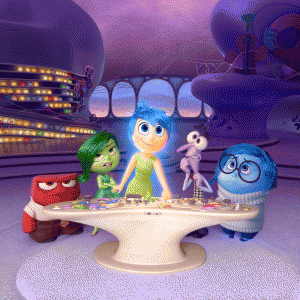
The end credits of Pixar’s “Inside Out” (released June 19) shamelessly dedicate the movie to the animators’ kids. “Please don’t ever grow up,” they implore and it’s not hard to see why after watching. You know that old saying about only truly appreciating things when they’re gone? Boy, was that true when it came to my (and I’m sure your) relationship with Pixar, the studio who raised us ‘90s kids on a diet of talking toys and inventive bugs.
Disney’s subsidiary animation studio hasn’t released a feature since 2013’s “Monster’s University” and its absence for two summers didn’t really register with me until I saw “Inside Out.” The mind is a hard thing to comprehend. It’s full of abstract thoughts and dark subconscious fears (according to Freud, at least). Turning this aspect of the human experience into a children’s movie sounds like it could be near impossible, but believe me when I tell you Pixar gets it right.
They’ve spent years making movies for kids so the only logical step was to go into the mind of one. The story part centers on a Minnesotan girl named Riley Anderson (voiced by Kaitlyn Dias) who loves home and hockey. What could go wrong for an 11-year-old on the brink of adolescence? One word that many kids (including myself) hate: moving to a new place. Her dad gets a job in San Francisco and suddenly things just aren’t the same — her friends and hockey team are gone.
Things inside Anderson’s head aren’t going any better. Not since “Osmosis Jones” has a film done a breathtaking job of imagining the processes going on within our bodies. There are different “islands” of Anderson’s personality that encompass things like family, honesty and goof ball-ish tendencies. Her anthropomorphized emotions are all in a tizzy as they try to comprehend this brand new lifestyle change and each one is perfectly cast and color-coded.
Joy (Amy Poehler) tries to keep this ragtag bunch of feelings in check as a yellow Tinker Bell-esque ball of, well, joy! Sadness (Phyllis Smith) is a blue Debbie Downer who can’t seem to find a silver lining in anything. Fear (Bill Hader) is a purple exposed nervy-looking fella in a sweater vest. Disgust (Mindy Kaling) is the diva of the group, the shade of green of a child’s worst enemy, broccoli! Anger (Lewis Black) is a fiery ball of red-hot fury who so desperately wants to use curse words to express himself.
Things get complicated when Joy, Sadness and Anderson’s core memories (important memories that make you who you are) get lost from headquarters. They must return the memories in order to return Anderson to her normal sense of self and rationality. The animators got to have a ton of fun with the journey through the different parts of the mind like a chamber used to process abstract thought, a Warner Bros.-like studio dedicated to producing dreams and the perpetually locked area of the subconscious that houses Riley’s worst fears.
The two emotions get help from an imaginary friend named Bing Bong who has long been out of a job, represented by his tattered jacket and gloveless hands. But he’s made of cotton candy and cries caramel so it can’t be all bad, right? Voiced by Richard Kind, he is a delightful elephantine guide who will blindside you with his likeability. At the same time, we see the toll that this internal strife is taking on Riley as she makes some rash decisions.
Both the inside and outside of the movie are created with care and are enough to make you bawl your eyes out. It is very much a story about the loss of innocence just as it is a lesson in how much we need all of our emotions to function properly lest we become psychopathic individuals in the vein of “Dexter.” That analogy may be too extreme.
All in all, Pixar aims to please and they seem to be making up for their extended absence with another movie out in November, “The Good Dinosaur.” With full knowledge that I may be attacked by an angry mob, I’d say “Inside Out” is better than “Toy Story” if not on the same level. In any case, it’s the best movie the studio has released since “Toy Story 3” and the most original since “Up.”
Directed by Pete Docter — the man who brought you tearjerkers like “Monsters Inc.” and “Up” — makes sure that the adults have just as much fun as their kids with plenty of profound insights on the human mind and pop culture gags that would put a smile on Jack Nicolson’s face with a reference to “Chinatown.” The movie plays with our emotions both figuratively and literally to create a beautiful piece of animation that touches our hearts and souls. It’s not just for children; it’s a story that can speak to anyone regardless of age. You’ll laugh, cry and everything in between.


